The 2013 Nissan GT-R
The Nissan GT-R’s power is anchored by its advanced VR38DETT twin-turbocharged 3.8-liter, six-cylinder engine that’s matched with a high-performance six-speed, dualclutch transmission. Nissan’s GT-R engineer team has been able to coax even more power and torque from the latest edition. For 2013, engine performance has been improved as its horsepower has been increased to 545 hp @ 6,400 RPM (versus the previous 530 hp), and torque to 463 lb-ft (versus the previous 448 lb-ft). Engine response and torque at mid- and low-speeds, and power at high revolutions, has been significantly improved. The most impressive change is to its torque, which when delivered at @ 3,200 – 5,800 RPM. A major refinement to GT-R’s renowned engine includes improved intake efficiency. This was accomplished by reduced airflow resistance as a result of an enlarged air intake duct for the intercooler. The engineering team also increased exhaust flow efficiency. The adoption of a newly designed metallic sodium-filled valve has helped to improve exhaust valve cooling performance. At the same time, valve control timing, the air mixture ratio and ignition timing were also improved from the previous year engine.

The 2013 model is offered in two versions: the GT-R Premium and the GT-R Black Edition.
The VR38DETT features a high-strength, aluminum closed-deck block that is cast with 0.15 mm (0.006 in) plasma-sprayed cylinder liner bores. The turbine housings for the two IHI turbochargers are integrated into the exhaust manifolds to decrease weight and bolster air flow balance. It also includes a secondary air management system for improved cold-start emissions performance. The engine sports a pressurized lubrication system controlled thermostatically. It has an oil scavenger pump to maintain oil flowing to the turbochargers and a lateral wet and dry sump oiling system. And yes, the engine is still being hand-assembled in a special clean room. Even with all this highly refined power, the GT-R has earned an ULEV-II emission rating.
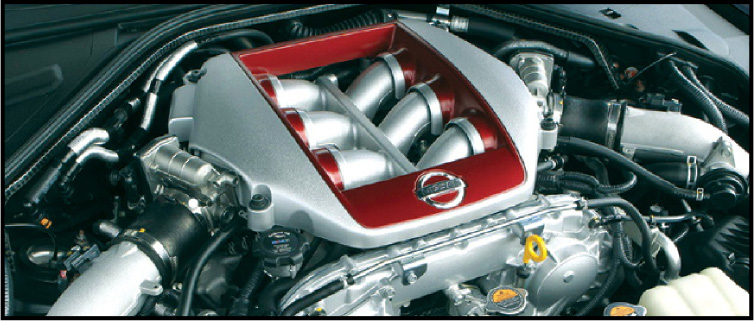
The transmission has been refined. The advanced paddleshifted, sequential six-speed dual clutch GR6Z30A transmission, allows the driver to select and shift at race car-like speeds. Transmission shift feel and quietness were improved over the previous model by strengthening the design of the shift fork arm and adding a firmer fixing bearing for the flywheel housing. The sequential-shifting design features separate wet clutches for the odd (1, 3, 5) and even (2, 4, 6) gears and pre-selects the next highest and next lowest gear to help when shifting.
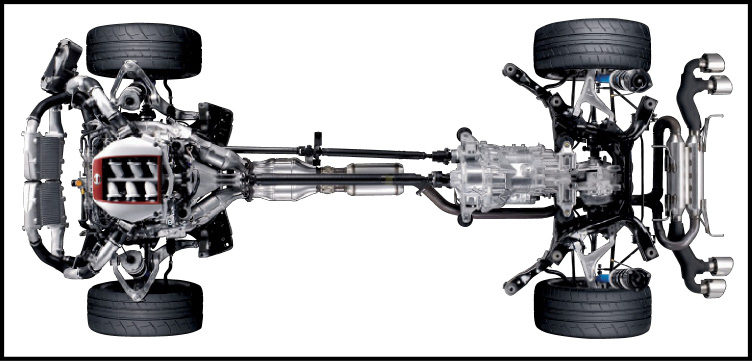
Rear Transaxle
GT-R is built on an exclusive Premium Midship platform, which enables the use of the world’s first independent rear transaxle ATTESA E-TS all-wheel drive system. The rear transaxle ATTESA E-TS all-wheel drive system places the transmission differential, and all-wheel drive transfer case at the rear of the vehicle, without the use of traditional torque tubes. This allows the suspension to operate independently and optimizes tire grip at each corner.
The rear drive-biased system can vary torque split depending on speed, lateral acceleration, steering angles, tire slip, road surface and yaw rate. The system decides on the power split and can send as little as 1 percent or as much as 50 percent of available torque back to the front axle via a second propeller shaft. The other propeller shaft goes from the engine to the rear-based gearbox, sending power through a limited slip differential that varies the left/right torque split to the rear wheels. Under normal road conditions, the system provides up to 100 percent rear-wheel power delivery. The unique offset input and reaction shaft design of the rear transaxle contributes to overall vehicle balance and low center of gravity. Also, high-performance differential oil R35 COMPETITION type 2189E, used in GT-R motorsports competition, is now standard for production models.
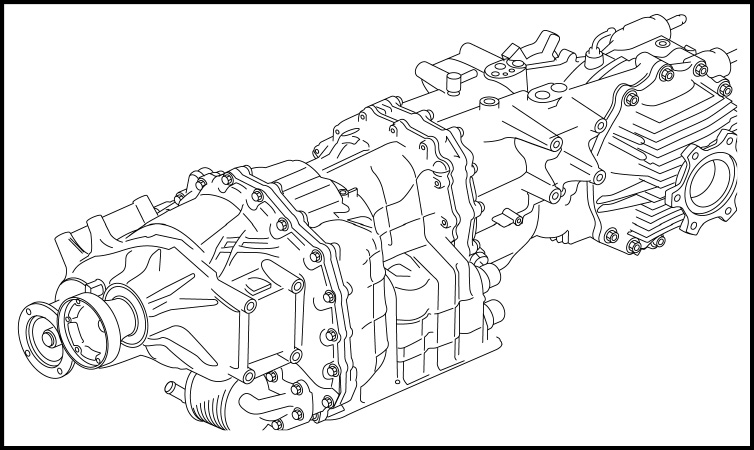
Suspension, Steering and Handling
The GT-R suspension for the 2013 model year has been retuned and adjusted for optimal performance. The retuning has improved responsiveness and smoothness, which the driver feels when steering. The suspension modifications have also provided enhanced cornering feel and ride comfort. This is managed by a sophisticated, independent double-wishbone front suspension and an independent multi-link rear suspension system. The rigid front and rear suspension subframes are assembled in high precision jigs. The vehicle again utilizes special Bilstein DampTronic electronically controlled shock absorbers. This driver adjustable shock absorber system utilizes three-mode variable dampers and progressive rate (non-linear) springs manufactured to race car tolerances. This system, along with the vehicle-speed-sensitive power rack-and-pinion steering, provide a high level of control. Suspension adjustability is provided by three settings – R mode, normal mode and COMF. There are three set-up switches located in the center of the instrument panel enable the driver to adjust transmission shifts, shock absorbers and the Vehicle Dynamic Control (VDC) for ultimate handling of the GT-R.
Brakes, Wheels and Tires
The braking system consists of Brembo® four-wheel vented disc brakes with two-piece full-floating rotors and 6-piston front and four-piston rear calipers (15.35-inch front rotors, 15.00-inch rear rotors). The calipers utilize race car-style radial mounting that helps to minimize caliper flex during extreme braking and low-steel high stiffness brake pads to minimize fade and provide excellent stopping performance. The GT-R Premium edition offers Nissan Carbon Ceramic Brakes (NCCB) that help with road hold and improve rotor longevity. Brake control is provide by the 4-wheel Anti-lock Braking System (ABS) with Electronic Brake force Distribution (EBD).
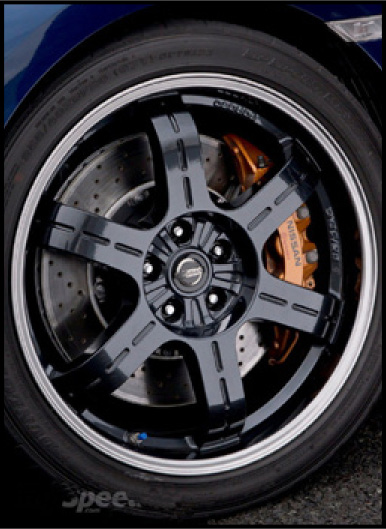
The GT-R’s Black Edition features special metallic black six-spoke RAYS® lightweight forged wheels in place of the Premium model’s 10-spoke design. These sleek looking, high-performance wheels are mounted with Dunlop Sports Maxx GT 600 DSST CTT tires – P255/40ZRF20 run-flat tires in front, and P285/35ZRF20 in the rear. The Dunlop high-performance tires feature a high-grip, sillica-reinforced tread compound and a center rib to help enhance steering response.
Exterior Features
Nissan GT-R’s aerodynamics was improved last year by increasing the front and rear downforce. The body features a lowered coefficient drag which was reduced to 0.26 (from 0.27). The newly refreshed front fascia features aggressive double aerodynamic fins and integrated daytime LED running lights. Other exterior features include high-mounted LED stoplights, bright four-ring LED rear combination taillights and “super wide” High Intensity Discharge (HID) low-beam xenon headlights. The headlight design is equipped with three additional sub-reflector plated parts that help enhance the car’s strong visual presence. Other exterior features include heated door mirrors and flat-blade, speed-sensitive windshield wipers.

The redesigned rear fascia features new venting and incorporates a sculpted lower section and extended length.
Cooling performance for the muffler was improved and rear down force was increased by about 10 percent through use of a new rear fascia outlet and new vents on the lower rear fenders. This design helps remove air from the rear wheel wells. Dual exhausts with four large-diameter tailpipe finisher tips were also added.
The GT-R Black Edition comes standard with a new dry carbon rear spoiler, which was designed to slip thru the wind while also being attractive to the eye. Handmade in a limited monthly production run, a special coating allows carbon fiber “weave” to be felt by the touch. As you may know, dry carbon fiber body component materials are used for professional race cars and are functionally strong and light weight.

Important Note: The dry carbon fiber rear spoiler may turn yellow due to age deterioration because of the characteristics of the material. Storing the vehicle outside in direct sunlight for extended periods of time may cause discoloration and deterioration. Nissan recommends you do not store the vehicle outside in direct sunlight.
Interior Features
The GT-R’s four-passenger cabin provides balance with functionality and a sense of ease and comfort. It features sculpted performance bucket seats for an optimal driving position, and a cockpit-style instrument panel with lighting added inside the large center-mounted tachometer. The addition of a new blue lighting treatment inside the tachometer ring matches the shift position indicator light. The centerpiece of the instrument panel is a video game-inspired multi-function display. There are 11 screens of information available for 17 performance parameters including: mechanical and driving information, acceleration, brake pedal pressure, and steering angle, as well as an on-board driving recorder. The Black Edition GT-R adds custom red and black Recaro® leather-appointed seats, with a red and black interior trim and a dark headliner with a carbon fiber trim.
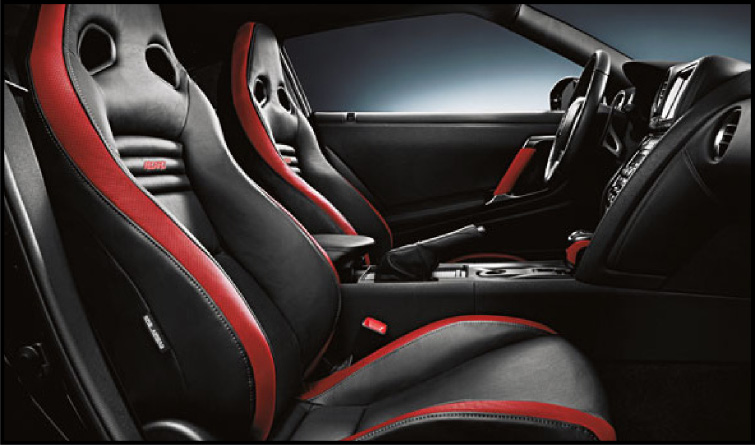
Standard equipment such as the 11-speaker Bose® sound system with Bose precision sound system woofer speakers mounted in rigid aluminum die cast panels, provides sound quality suitable for the acoustical performance of the GT-R supercar. The 2013 models have also been equipped with other additional standard equipment like a RearView monitor, Nissan navigation system with XM NavTraffic® with Real-Time Traffic Information and NavWeather™ capabilities, Streaming Audio via a Bluetooth® Handsfree Phone System, and USB iPod interface.
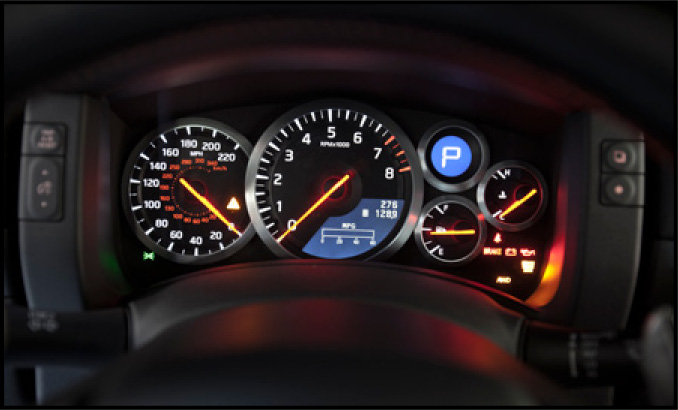
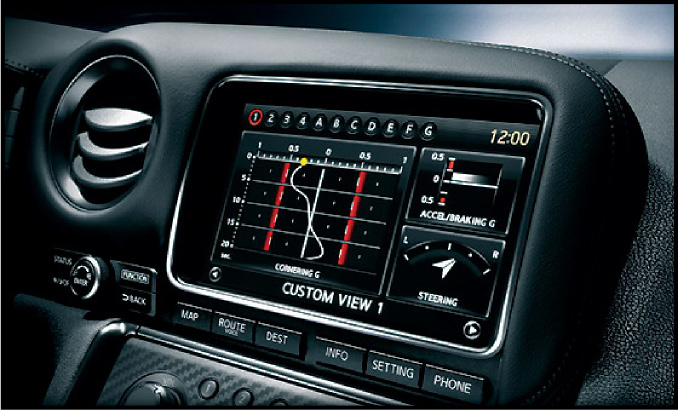
Safety
Standard safety equipment includes a Nissan Advanced Air Bag System for driver and front-passenger. The system consists of front seat-mounted, side-impact supplemental airbags for driver and front-passenger and standard roof-mounted curtain side-impact supplemental airbags for front seat occupant head protection. The seat belts include pretensioners with load limiters and tension reducers in the front. The drivers seat is a three-point ELR, and the right front seat and the rear seats a three-point ELR/ALR.
The GT-R has Zone Body construction with front and rear crumple zones to help absorb impact energy in a collision.
The Driving Assist Display Mode provides information on accelerator, brake and steering operations to improve the driving technique. It also displays the longitudinal/transverse G history.